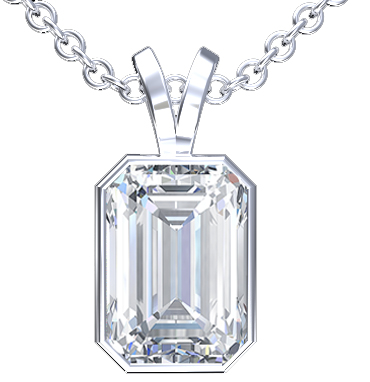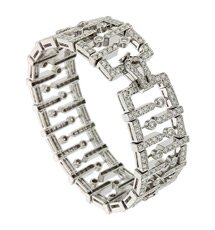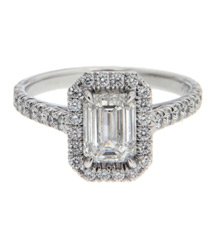The Emerald Cut appeared in the late 1800s, though the exact origins are not quite known. Originally the cut’s rectangular step-like four sided facets were created for emerald gems, but soon after diamond cutters realized that the shape could be used for diamonds also. The form itself was developed to reduce the amount of pressure used when cutting the gem and to protect it from chipping, which is why diamond cutters found it important.
Emerald cut diamonds do not offer the brilliance and fire that other diamond cuts have, but this shape has a unique mirror effect and natural crystalline rectangular look, giving it a graceful and rich appeal. Due to the emerald cut’s large facets, it’s easier to spot inclusions with the naked eye. It is recommended to look for an emerald cut diamond with a higher clarity grade than SI1, and to consider the length to width ratio of this stone. Usually the ratio should be between 1.30 and 1.50, as a lower ratio will give the diamond a more squarish look.
The Clear Crystal of Emerald Cut
Emerald gemstones contain a wealth of visual interest within their crystals, but are delicate to handle. To protect the jewels from accidental chipping and show off their internal beauty, emeralds are cut into rectangles with truncated corners. The facets sit parallel to one another so that play of light doesn’t disguise the stone’s clarity. This cut is so ubiquitous for emeralds that the cut is named for the jewel. However, the cut isn’t limited to emeralds.
 In gem cutting, step cuts have square or rectangular shapes with their corners cut off. Strictly speaking, they’re octagons, though the clipped corners tend to be discreet, giving the impression of a four sided shape. Their top and bottom facets are quite wide while their crowns and pavilions are shallow. Other distinctive features of step cuts are broad facets on the top and bottom of the stone, with parallel side facets. It is a cut that specializes in clean lines.
In gem cutting, step cuts have square or rectangular shapes with their corners cut off. Strictly speaking, they’re octagons, though the clipped corners tend to be discreet, giving the impression of a four sided shape. Their top and bottom facets are quite wide while their crowns and pavilions are shallow. Other distinctive features of step cuts are broad facets on the top and bottom of the stone, with parallel side facets. It is a cut that specializes in clean lines.
Art Deco originated in France in the 1920s, celebrating industry alongside ancient civilizations. The aesthetic influenced everything from architecture to fashion, and jewelry was no exception. Clean lines, bold colors, symmetry and gleaming surfaces signaled luxury and taste. This period belonged to the emerald cut diamond, with its strong polish and striking geometry.
Compared to a round brilliant diamond’s 57 or more facets, emerald cut diamonds have a modest 49. The facets that ring the girdle sit nested inside one another in concentric rectangles two to four levels deep. Paired with even sides and a 1.5:1 length to width ratio, an emerald cut diamond is a marvel to look at.
As emerald cut stones are designed to showcase the jewel’s interior, beauty and imperfections are placed on display. Diamonds with a VS2 grade or higher make an excellent match with this cut. With minimal play of light to take away from a crystal’s hue, very light colored diamonds also pair well with this cut. Those who yearn for a diamond with a vintage look and simple elegance would do well to consider emerald cuts. Their minimalistic design offers a strong impact on the viewer, delighting the eye without special effects. Emerald cuts highlight the best aspects of a diamond.
When A Diamond is an Emerald
Emeralds are beautiful, but require special care and consideration due to their fragile nature. They are most often cut into cabochons, or a rectangular cut with parallel facets and a large table and culet. The latter is so strongly linked to emeralds that the cut is named after the jewel. Emeralds and the emerald cut are not exclusive. Other jewels, including diamonds may also have emerald cuts.
Emerald cut diamonds have about 49 facets in total, though the number may vary. There may be two to four sets of concentric facets edging the pavilion and crown, not counting the girdle. Emerald cuts frequently have cropped corners to discourage chipping. Its stepped style of faceting downplays the brilliance and fire of a diamond while serving as a means to highlight the jewel’s clarity.
The best emerald cut diamonds should have even corners, parallel sides, and a length to width ratio that isn’t too narrow, though square emerald cuts exist. A 1:1.5 ratio is the most common shape. It’s also important to have a good color for emerald cut diamonds, as the lower brilliance makes the jewel’s hue all the more prominent.
This cut’s eye catching shape and ability to highlight strong quality diamonds, makes it well suited as central stones. Their luster and straight lines made them popular in the early to mid-1900s, and are enjoying a resurgence in the present. People looking to make a statement with designer engagement rings may do well to consider emerald cut engagement rings.





